The Role of Glass Partition Walls in Modern Spaces
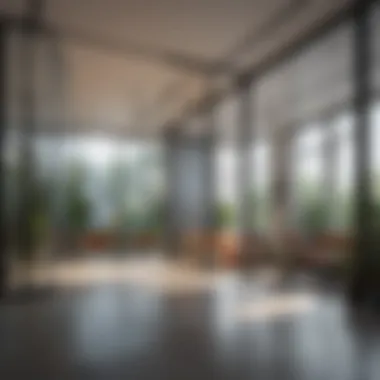
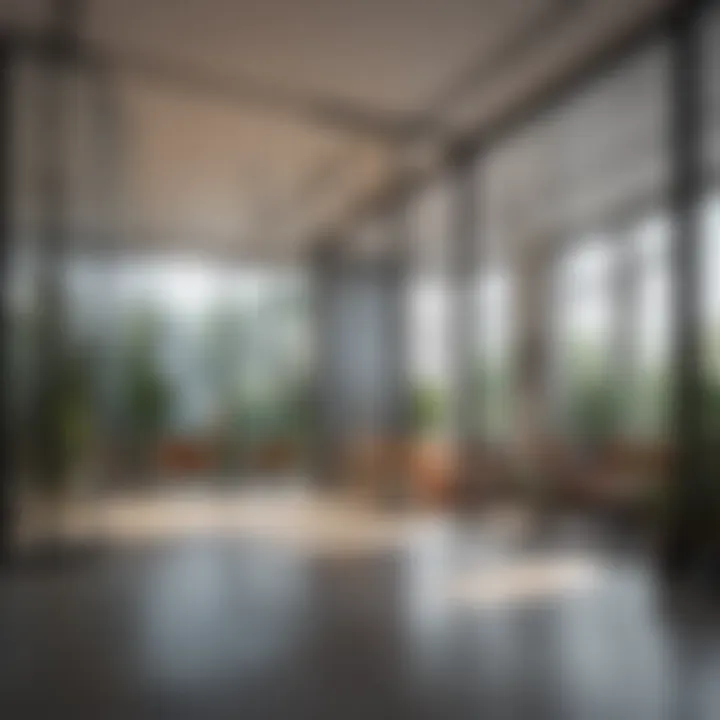
Intro
In modern design, the appeal of interior glass partition walls goes beyond mere aesthetics; it's about enhancing the functionality and flow of spaces. As we delve into this topic, let's explore how these partitions bridge the gap between openness and privacy, allowing homeowners and design professionals to innovate in their environments. The versatility of glass partitions can significantly transform how we perceive and interact within a space. These installations not only redefine boundaries but also invite natural light, making any area feel larger and more inviting.
Interior Design Tips
When contemplating the integration of glass partition walls, it's vital to consider not just the aesthetic angle but also practical applications that cater to specific needs. Here are some handy pointers to elevate your interior design:
Trendy Design Ideas
- Sliding Glass Panels: Opting for sliding panels can save space without compromising on style. They work wonders in studio apartments or small offices.
- Framed Glass Dividers: These add an industrial touch while maintaining an airy feel. Using black metal frames against white walls can be striking.
- Frosted Glass: For more privacy, frosted glass panels can obscure views while still allowing ambient light to filter through.
Color Schemes and Combinations
The color palette surrounding your glass partition plays a significant role in overall design cohesion.
- Bold Contrasts: Mixing dark wood with clear or frosted glass creates a powerful visual contrast.
- Monochromatic Tones: Keeping a similar color scheme for adjacent rooms can create seamless transitions while using glass to delineate spaces.
- Accent Colors: Utilize vibrant colors in furnishings or wall art to break up the neutrality of the glass and create focal points.
Furniture Arrangement Techniques
Arranging furniture around glass partitions can enhance the perceived space:
- Zoning Areas: Use the glass to define different zones, like workspaces versus relaxation areas, while keeping an open feel.
- Reflective Surfaces: Place mirrors or light-colored furniture near glass walls to amplify light and depth.
- Flow and Accessibility: Ensure that the arrangement allows for easy movement between spaces without obstructions.
Incorporating these tips can revamp your living environment, making it not only more attractive but more functional as well.
"The use of glass walls can make even the smallest rooms feel like they have no limits, giving a sense of freedom in design."
By thoughtfully approaching the design and layout of glass partitions, one can achieve remarkable changes in how spaces communicate with each other. The next sections will delve into how the unique properties of interior glass can also enhance other facets of your home, such as entertaining and decor.
Understanding Interior Glass Partition Walls
The integration of glass into interior design has transformed the way we think about space. Interior glass partition walls stand at the forefront of this change. These structures not only redefine physical boundaries but also enhance the aesthetic environment in which they are placed. This section will explore the fundamental aspects surrounding these partitions - their definition, purpose, and historical context. By understanding these elements, homeowners and design enthusiasts can fully appreciate the versatility and impact of glass partitions in modern spaces.
Definition and Purpose
Interior glass partition walls are thin structures made primarily of glass, which are used to divide spaces while maintaining an open feel. Essentially, they serve to create distinct areas without sacrificing light or visual connectivity, which is a common issue with traditional walls. The purpose behind these partitions is manifold:
- Space Optimization: Glass partitions allow for the effective division of space without the heaviness of solid walls, making areas feel larger and more welcoming.
- Aesthetic Appeal: They add an element of sophistication and modernity to interiors. The clear lines and reflective surfaces can enhance the overall design of a room, elevating the look and feel.
- Functional Clarity: By categorizing different functions within a space, these partitions help in defining boundaries, whether for a residential layout or a bustling office.
- Environmental flow: They facilitate the flow of natural light, bridging spaces and allowing light to filter through, improving the atmosphere.
History and Evolution
The use of glass as a building material dates back centuries, but the concept of interior glass partitions has seen significant development in more recent years. Initially, glass was viewed merely as a window material.
Over time, as architectural styles evolved through the Industrial Revolution, glass became a synonym for modern design and innovation. It started transitioning from an external material to an interior one, reflecting changing attitudes towards transparency and openness in space. The glass partitions were first introduced to maintain privacy in office spaces while keeping the lines of communication open among employees. Gradually, they made their way into homes, showing versatility in living areas, workspaces, and even leisure environments.
Today, with advancements in technology, glass partitions are available in various styles and functionalities, including soundproof versions and those that incorporate smart technologies. From simple clear glass to frosted or colored options, their evolution reflects broader trends in sustainability and design, marking a shift toward minimalism and eco-conscious choices in interior architecture.
"As buildings and spaces become more versatile, the role of interior glass partitions has transformed from functionality to an essential design element."
In exploring interior glass partition walls, we open a window to understanding how they serve not just as physical barriers but as enablers of design creativity and spatial dynamics.
Types of Glass Partition Walls
When discussing interior glass partitions, it is essential to understand the different types available on the market. Each option brings its own flavor to the spatial composition, affecting not just aesthetics, but also functionality. Choosing the right type can significantly enhance how a space feels and operates. Whether you're looking to create a modern office ambiance or fuse elegance with practicality in your home, knowing these types is a key step.
Frameless Glass Partitions
Frameless glass partitions exemplify minimalism at its finest. By eliminating bulky frames, these partitions create a seamless appearance that helps maximize natural light. This transparency adds a sense of openness, contributing to the spatial flow of a room. Imagine walking into a sleek, contemporary office, where the lines between workspaces blur, thanks to bold frameless partitions. They can redefine areas without completely isolating them, providing an airiness that traditional walls can’t match.
In residential settings, frameless glass partitions can serve various purposes, such as dividing a living room from a dining area while maintaining uninterrupted sightlines. They are often made from tempered glass or laminated materials for safety, making them both attractive and durable. Though they shine in style, it's important to consider their weight and installation; a professional touch might be needed to ensure they are safely anchored.
Framed Glass Partitions
Framed glass partitions offer a different aesthetic while providing more structural support than their frameless counterparts. The metal or wooden frames can complement the existing decor while also providing a level of sturdiness to the barriers. These partitions can either be full-height or go halfway up a wall, allowing for creative configurations that can accommodate various design themes.
Framed partitions can work wonders in both commercial and residential setups. For example, in a retail space, it allows displaying products while still defining sections. On the flip side, in a home office, a framed glass wall can denote the workspace, providing a dedicated area without entirely closing it off. They come in an array of finishes, with colors that can either contrast or harmonize with the space. An aspect to mull over is their sound attenuation properties, as framed versions may not offer the same noise reduction as solid walls do.
Sliding Glass Partition Walls
Sliding glass partition walls bring an element of versatility that can be a game-changer in any setting. These partitions allow you to adjust your space according to your needs effortlessly. When closed, they provide distinct areas, but when opened, they can create expansive, multifunctional spaces. This is particularly useful in dynamic environments where different functions are needed throughout the day, such as in conference rooms that double as collaborative spaces.
In homes, sliding glass partitions can serve as room dividers or even closet doors, making them a practical choice for smaller spaces where flexibility is essential. Their smooth operation can be a delight, ensuring that transitions between spaces are light and easy, whether it's moving from a cozy area to an open lounge or shifting from a quiet study to a vibrant living area. Just like with the other types, care must be taken regarding installation; adding tracks and ensuring they glide smoothly can be a bit of a task for those going the DIY route.


Benefits of Using Glass Partitions
Using glass partitions in interior design can bring a myriad of advantages that elevate not just functionality but also aesthetics of any space. While some may still have a bias towards traditional walls, the benefits of integrating glass partitions are becoming undeniably compelling. This section will unpack the key elements that make glass partitions a smart choice in both residential and commercial settings.
Enhanced Natural Light
One of the standout features of glass partitions is their ability to maximize natural light, creating a warm and inviting ambiance. In spaces where light can sometimes be scarce, introducing glass walls allows sunlight to stream through, giving rooms a more spacious feel even when square footage is limited. This enchanting quality can turn a dull corner of an office into a vibrant workstation, or just brighten up a cozy home library.
Moreover, studies have shown that exposure to natural light can improve mood and productivity. A workspace flooded with sunshine can significantly enhance employee well-being—a bright spot that no one can overlook. As many people are working more from home these days, homeowners looking to improve their work-from-home setups may find they want to implement these glass solutions into their personal office spaces.
Incorporating glass partitions into designs not only meets functional needs but also aligns with contemporary tastes, encouraging well-being and inspiration.
Visual Openness and Spatial Flow
The aesthetic appeal of glass partitions goes beyond mere looks. They create a sense of visual openness, allowing for seamless interactions between spaces. One can appreciate the carefully curated decor of the living room while preparing a meal in the kitchen without breaking the visual connection. This harmonious flow can be particularly beneficial in marketing spaces or cafes, where ambiance plays a crucial role in attracting patrons.
Consider any team meeting in a corporate office. A room separated by glass not only helps participants feel connected to the rest of the office but also encourages collaboration and communication across departments. The design creates a bridge rather than a barrier, breaking the traditional confines often imposed by solid walls. This is especially critical in an environment that thrives on teamwork and the free exchange of ideas, making glass partitions a vital element in fostering a modern workplace culture.
Sound Reduction Properties
While one might assume glass equals noise, modern interior glass partitions come with properties designed to combat sound. Enhanced with soundproofing technologies, these partitions can stifle distractions in any environment. Whether it’s a bustling office filled with chitchat or a busy café, the right treatment in glass can ensure that conversations remain private and focused.
In residential settings, they can work wonders in bathrooms or home studios, creating a quiet retreat where one can relax without disturbance. The thickness and type of glass used play a significant role in achieving the necessary sound insulation. This becomes essential in environments with different noise levels, ensuring that tranquillity is preserved where desired.
"Glass partitions harmoniously balance aesthetics and functionality, addressing both the practical and emotional needs of today’s spaces."
The choices made around glass partitions can change the perception of a place entirely. The take-home message is clear: benefits such as enhanced natural light, improved visual openness, and sound management make these partitions a worthy investment for anyone looking to refresh their space.
Integrating glass into design is not merely about style; it signifies a broader commitment to a well-thought-out living or working environment. As we explore more on applications and considerations, it becomes evident why glass partitions are so much more than just dividers.
Design Considerations
When it comes to interior glass partition walls, design considerations are paramount. These choices significantly impact both functionality and aesthetic appeal. The right design can enhance natural light, create openness, while also addressing privacy needs. As such, careful planning is essential in making the most of glass partitions.
Choosing the Right Glass Type
Tempered Glass
Tempered glass is often seen as a top contender in interior partition designs. Its strength is one of its most appealing characteristics. This type of glass is heated and then rapidly cooled, making it much tougher than ordinary glass. For spaces requiring safety and robustness—like busy office environments—tempered glass is a shrewd choice. 👍 It can withstand impacts and is less likely to shatter into sharp, dangerous shards.
However, one must also consider the limitations. Its thickness can reduce visibility slightly, which might affect one's aim for an entirely open feel. Yet, the safety and durability benefits often outweigh any slight obstruction.
Laminated Glass
Laminated glass is another alternative that merits attention. This type consists of multiple layers, with an interlayer between them, enhancing its security features. If shattered, the layers hold together, reducing the risk of injury—making it an excellent choice for spaces frequented by children or large crowds.
Its unique feature is the ability to include decorative elements within the layers, allowing for personalized designs that can match the aesthetics of any room. 🌟 However, keep in mind that these added security and design elements can increase the cost, but many find it well worth the investment.
Frosted Glass
Frosted glass is an interesting option that offers both privacy and style. This glass is made opaque through a special treatment, making it ideal for spaces where modesty is a concern—like bathrooms or offices. The frosted surface diffuses light, creating a softer ambient glow while obscuring visibility into the room.
A key characteristic of frosted glass is its versatility in design; it can fit well into many decor styles, from modern to traditional. However, it should be noted that the lack of clear visibility might not suit every context. If a space aims to project openness fully, frosted glass might not be the best pick.
Color and Finish Options
The color and finish of glass partition walls play a crucial role in their integration into a larger design scheme. There are countless options available—ranging from clear and tinted designs to textured and patterned finishes. The choice of color can influence a room’s mood and functionality. For instance, darker tints often add a more sophisticated vibe, while lighter tones may maximize the sense of space.
Additionally, certain finishes like matte or glossy can convey entirely different aesthetics. Thus, balancing functionality with stylistic preferences becomes vital in creating a cohesive environment.
Integration with Other Design Elements
Glass partitions must harmonize with the other design elements in a space. This can mean matching the glass with furniture, lighting, or flooring choices. For example, the sleekness of glass can complement modern wooden finishes and metal accents beautifully.
By ensuring that the glass works symbiotically with other materials, the overall look can feel intentional and thoughtfully designed. It's about creating a synergy that not only pleases the eye but also enhances the usability of the given space.
"When glass partitions don’t just split spaces but elevate them, that’s when design truly shines."
Each of these design choices is integral to achieving not just a visually appealing space, but also one that works well. For homeowners and design enthusiasts alike, understanding these considerations can transform how glass partitions are viewed—moving them from mere separators to essential elements of refined spatial dynamics.
Installation and Maintenance
The installation and maintenance of interior glass partition walls are critical components that can significantly impact their functionality and aesthetic appeal. When choosing to incorporate these partitions, both novices and professionals must acknowledge the unique challenges they pose, requiring a thoughtful approach to ensure they contribute effectively to the space. This section will delve into the essential elements surrounding installation and maintenance, aiming to provide insights into a smooth and efficient process that can yield lasting benefits.
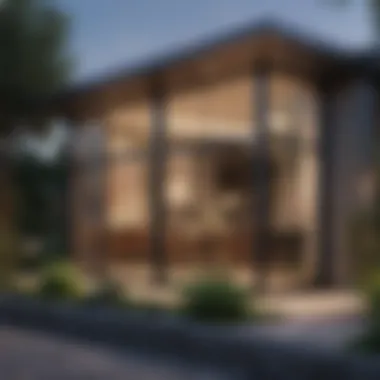
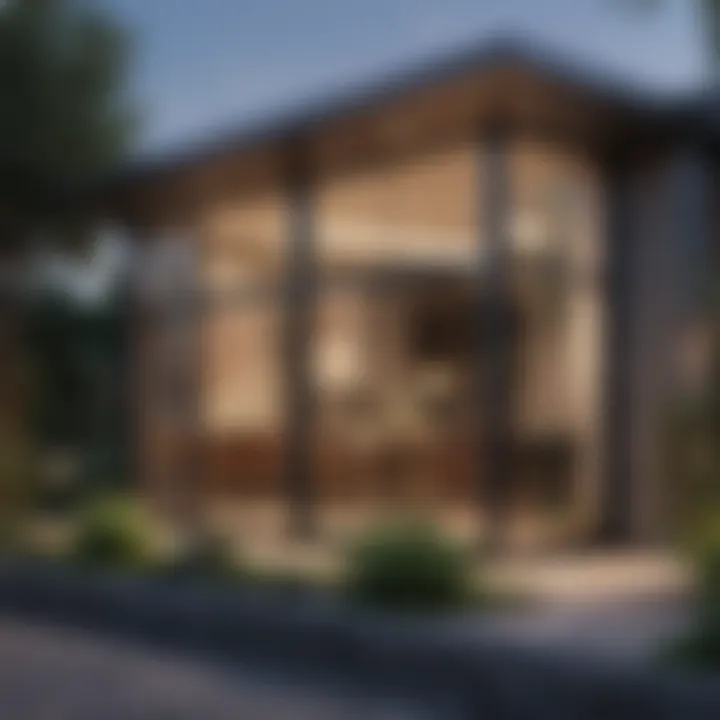
Pre-Installation Planning
Prior planning before installation is paramount. It could be the difference between a flawless finish and a costly redo. First and foremost, assess the space where the glass partitions will reside. This evaluation should consider factors such as the purpose of the area, existing dimensions, and how the glass walls will impact light flow and visual openness. It's wise to draft a layout sketch that outlines the intended design. Choosing the appropriate type of glass and framing is another crucial decision. Depending on the desired ambiance—be it sleek and modern or more traditional—options like tempered or frosted glass may suit the needs best.
Essential steps in pre-installation planning can include:
- Regulatory Compliance: Ensure that the planned installation meets local building codes and safety regulations.
- Material Selection: Choose suitable glass types based on durability and desired aesthetics.
- Professional Consultation: If unsure about any specifications, consulting with design professionals can be invaluable.
This preparation phase sets the stage for a smooth installation process, ultimately leading to an efficient use of both time and resources.
Professional Installation vs. DIY
One pivotal question homeowners often grapple with is whether to seek professional help or tackle the project themselves. Both routes have their advantages and drawbacks.
Professional Installation
Opting for professional installers brings expertise and experience to the table. Their understanding of structural integrity, safety protocols, and aesthetic detail can greatly enhance the final result. Benefits include:
- Accuracy and Expertise: They know the ins and outs of fitting and finishing glass partitions.
- Safety: Professionals are trained to handle heavy, potentially hazardous glass materials.
- Time Efficient: They can often complete the job quicker than an amateur.
There’s also a downside. Hiring a professional can take a chunk out of the budget.
DIY Installation
On the other hand, doing it yourself can be appealing for those with a knack for handiwork. It may provide a sense of accomplishment and save on labor costs. However, potential pitfalls include:
- Quality Control: It’s easy to make costly mistakes without proper experience.
- Equipment: You may lack specialized tools necessary for installation.
- Time Commitment: What seems simple can spiral into a time-consuming project.
Ultimately, the choice hinges on personal skill levels, budget considerations, and the complexity of the installation. Knowing one's limits is key to achieving the intended outcome.
Care and Maintenance Tips
Maintaining glass partitions doesn't have to be a chore. With a bit of regular upkeep, they can remain sparkling and structurally sound. Here are practical tips for proper care:
- Routine Cleaning: Use a non-abrasive glass cleaner and a soft cloth to keep surfaces clear of grime. Avoid materials that could scratch the glass.
- Inspect Regularly: Look out for any chips or cracks, as these can exacerbate over time. Address small issues promptly to prevent further damage.
- Sealants: Depending on the type of glass and installation method, using sealants can help with water resistance and protection against wear.
- Mind the Environment: Keep in mind that factors like humidity and temperature fluctuations can affect glass integrity.
"A stitch in time saves nine" is a phrase that rings true when it comes to maintenance. Regular attention can prevent larger issues down the line.
Glancing at installation and maintenance holistically reveals their importance in elevating the advantages that glass partitions offer. By investing the time and resources upfront, they're more likely to yield practical and aesthetic dividends that enhance the living or working space.
Applications in Various Spaces
The importance of applications for interior glass partition walls cannot be overstated. These partitions serve not only as physical dividers but also as integral design features that enhance the overall aesthetic while promoting functionality across various settings. Different environments come with unique requirements, and glass partitions meet them in style, providing benefits that range from improving natural light flow to facilitating a seamless connection between distinct areas. Indeed, the adaptability of glass partitions transforms spaces into versatile venues ideal for work and play.
Residential Settings
Living Areas
Living areas are often the heart of a home, where families gather and create memories. Using glass partitions here can drastically change the ambiance, inviting natural light to flood the space, making it feel much larger and more open. The elegance of a visual barrier, rather than a heavy wall, provides a unique character to living rooms while still allowing for separate spaces. This choice is becoming increasingly popular for those looking to combine functionality with aesthetic flair.
The unique feature of living areas enriched by glass partitions is their ability to blend different sections while maintaining distinct zones for different activities, such as lounging or dining. However, consideration must be given to privacy; while these partitions enhance openness, they may not offer the complete seclusion one might want during quieter moments.
Workspaces
Transforming an at-home office with glass partitions can lead to a more motivating work environment. These structures can help delineate your workspace from the rest of your home, creating a boundary that fosters productivity. A key characteristic of glass partitions in home offices is their ability to foster an atmosphere of professionalism without sacrificing style.
One significant advantage of using glass partitioning in workspaces is the natural light that pours in, helping reduce fatigue, which can happen in more closed-off environments. Nevertheless, it’s essential to consider the sound-proof capabilities of the glass being used, as distractions from other parts of the home may interrupt concentration purposes.
Bathrooms
When it comes to bathrooms, using glass partitions can offer a sleek, modern touch to what can sometimes be a cramped space. Instead of feeling boxed in, a beautifully crafted glass shower wall can open up the area, giving the illusion of more room. The key characteristic of glass in bathrooms lies in its ability to combine functionality and style, allowing for easy cleaning while looking visually appealing.
Implementing this type of partition could enhance an overall luxury feel, which many homeowners desire in their private spaces. However, one must be mindful that clear glass might not always provide the privacy needed in such intimate settings, so the choice of frosted or tinted glass might become necessary depending on personal preferences.
Commercial Environments
Office Spaces
In commercial settings like offices, glass partitions are revolutionizing the way people think about work environments. They can enhance collaboration by making areas feel more interconnected while still defining personal workspaces. A significant feature of glass partitions in these contexts is their versatility—allowing businesses to quickly adapt their environments to changing needs.
Moreover, they help project a contemporary image to clients and visitors, aligning with the current trend of modern workplace design. A downside can be the potential for increased noise levels in open-office designs since sound can travel more freely in such environments, thus careful planning may help mitigate these effects.
Retail Settings
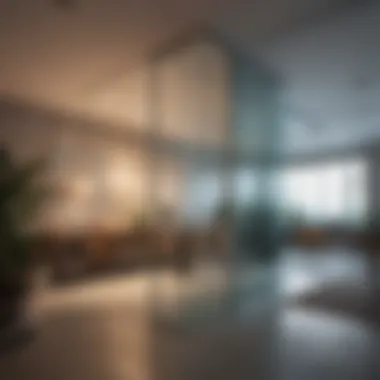
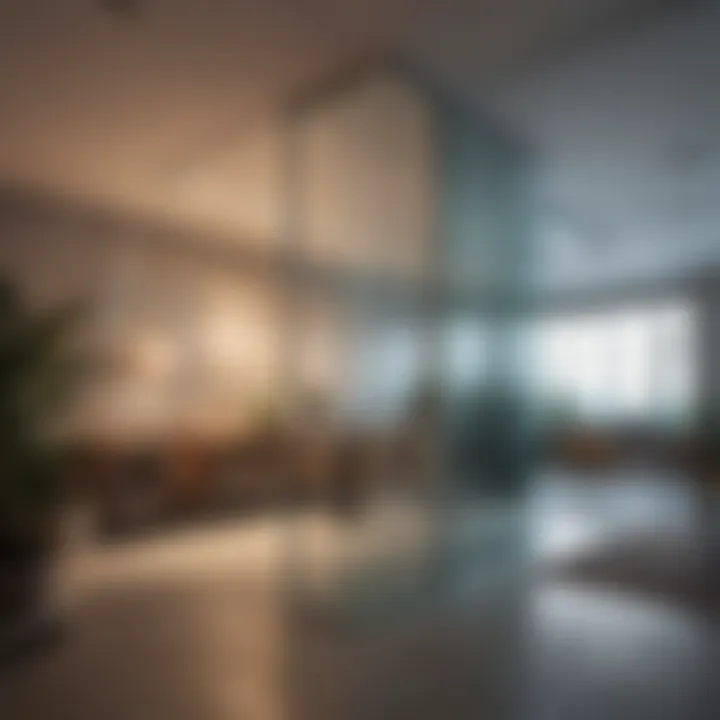
Using glass partitions in retail space can create an atmosphere of openness and accessibility, which is vital for customer engagement. They help define different sections of stores without making the space feel cluttered or overwhelming. A significant aspect of this in retail is creating visually appealing displays that catch the eye while allowing customers to navigate seamlessly through products and services.
Glass can be both practical and stylish in these settings, leaving an impression of cleanliness and modernity. One disadvantage to consider, however, is the potential for breakage or damage, leading to costly repairs which can affect the overall look of the space if not maintained properly.
Hospitality Venues
In hospitality environments, the use of glass partition walls is an excellent way to strike a delicate balance between privacy and social interaction. This application is particularly useful in hotels or restaurants, where distinct areas for dining or socializing can create a cozy atmosphere. The transparent nature of glass can maintain an environment of sophistication without compromising guest comfort.
Additionally, these partitions can significantly enhance the flow of natural light, contributing to an inviting ambiance. However, careful consideration should be given to ensure that some areas maintain the level of privacy necessary for a pleasant customer experience, which might require using tinted or textured glass options.
Public and Community Areas
Museums
In museums, glass partitions can redefine how art and exhibits are experienced. They are instrumental in crafting an open, airy feel while still showcasing art effectively. The transparency of glass invites guests to connect with their surroundings without physical barriers, fostering a more immersive experience.
A critical aspect of using glass in this setting is preserving sightlines and allowing for the natural flow of visitor traffic. However, potential drawbacks include the need for constant cleaning to ensure clarity and prevent smudges that might distract from the art experience.
Educational Institutions
In educational institutions, glass partitions can facilitate a modern learning environment that encourages collaboration among students and faculty alike. The key characteristic here is the sense of community they can create—allowing people to interact while still providing separate spaces for focused tasks, like studying or group projects.
Such environments, however, should also be designed thoughtfully to factor in sound isolation, as lively learning activities may require a degree of separation to minimize distractions.
Healthcare Facilities
In healthcare facilities, glass partitions can promote a healing environment. They often provide easy visibility for staff, ensuring that patient care is enhanced while still offering a level of privacy. The main advantage here is how light can improve mood and anxiety levels among patients, which is invaluable in healthcare.
However, consideration must be given to the unique needs for privacy in these environments; thus, glass materials used often include frosted or etched options to allow for confidentiality in sensitive situations.
In sum, the applications of glass partitions across residential, commercial, and public spaces speak volumes to their versatility and functionality, making them an appealing choice for enhancing spatial dynamics in various environments.
Challenges and Limitations
While interior glass partition walls offer a plethora of benefits, it is crucial to also explore the challenges and limitations that come with their implementation. Addressing these aspects ensures that homeowners and interior design enthusiasts have a well-rounded understanding of what to expect when considering glass partitions for their spaces. Cost, privacy, and durability are three specific elements that merit careful consideration.
Cost Considerations
The initial investment for glass partition walls can be steep compared to traditional materials like drywall. This includes not only the cost of the glass itself but also the installation process and any necessary finishing touches. High-quality tempered or laminated glass tends to be pricier because of their safety features and aesthetic appeal. Additionally, bespoke designs can further increase the budget.
Furthermore, if you're thinking about an elaborate installation, you might also want to factor in potential costs for structural reinforcement, especially in older buildings. The financial strain may deter some homeowners from fully embracing glass partitions, leading them to opt for more conventional alternatives. However, it's worth noting that the long-term benefits, such as increased property value and lower energy costs through enhanced natural light, could offset the initial costs.
Privacy Concerns
Another significant factor to think about is privacy. The open nature of glass partitions may not always align with the need for solitude or discretion in specific settings, particularly in residential spaces like bedrooms or bathrooms. People today are more conscious of their privacy, and glass barriers can make some feel exposed—especially if the walls are clear or minimally frosted.
To mitigate these concerns, there are several effective strategies. Frosted glass offers a playful balance, providing light while still hindering visibility. Alternatively, you might consider using window films or shades that allow for some customization according to personal preference. Blinds can also do the trick, adding a layer of versatility without compromising the overall elegant look. However, each option must be assessed for its practicality and cost-effectiveness daily.
Durability and Safety Issues
Finally, let’s not overlook the durability and safety aspects. Glass, while stunning and sleek, can also be vulnerable. There's a common misconception that glass is weak and prone to breakage. Yet, with advancements in technology, most modern glass partitions are both durable and safe. Tempered glass, for instance, is designed to be shatter-resistant, breaking into small, less harmful pieces if it does fracture.
That said, safety is still a concern, particularly in environments frequented by children or pets. Sharp edges and the potential for accidental breakage demand careful planning during installation. To ensure utmost safety, consider consulting professionals who specialize in glass installation for guidance and best practices to adhere to.
"When evaluating the use of glass partitions, think beyond aesthetics. Consider how comfort, practicality, and safety play vital roles in your space’s functionality."
Future Trends in Glass Partitions
As we navigate an ever-changing world, the notion of space and its utilization is evolving. Glass partition walls are no exception to this trend, quickly becoming integral components of modern design. With their unique ability to blend functionality and aesthetics, these partitions are setting the stage for innovative approaches to interior spaces. The focus on future trends in glass partitions is crucial as it encapsulates the direction we are heading towards in both our homes and workplaces. From the advent of smart technologies to a pronounced emphasis on sustainability, these elements encapsulate the shift in consumer expectations and industry practices.
Smart Glass Technologies
Smart glass technology is a game changer, bringing futuristic attributes to what traditional glass could only dream of. This innovation allows glass to adapt to varying conditions, such as light exposure, temperature, and even sound. Imagine a room where the transparency of a partition can change at the flick of a switch, adjusting to your privacy needs with ease. Not only does this enhance convenience, but it also adds an element of sophistication to any space.
- Dynamic Tinting: Some smart glass can alter its tint based on sunlight exposure, reducing glare and conserving energy. This could mean lower utility bills in the long run.
- Privacy on Demand: The ability to switch from clear to frosted at will means that homeowners and employers can maintain privacy when necessary, without sacrificing openness when desired.
- Integration with Smart Home Systems: Manufacturers are introducing smart glass solutions that work in tandem with existing smart home technology, allowing for seamless control via mobile applications.
By creating adaptable spaces, smart glass technology signifies a shift towards intelligent design. This innovation enhances both personal comfort and efficiency in daily routines.
Sustainability in Glass Material Use
With the climate crisis looming, there's a growing consciousness for sustainability in architectural design, and glass partitions are following suit. No longer are they just beautiful; they are also being manufactured with eco-friendliness as a core value.
- Recycled Glass Usage: Many companies now produce glass from recycled materials. This not only reduces waste but also minimizes the energy required for production.
- Energy-Efficient Manufacturing: New methods are emerging that demand less energy in the glass manufacturing process. This includes using renewable energy sources to power production facilities.
- Long-Term Durability: Glass partitions are not only aesthetically pleasing but are also incredibly durable. Their lifespan can exceed that of other materials, meaning fewer replacements and less waste over time.
This shift to sustainability is more than just a trend; it's indicative of a broader move towards environmental responsibility in interior design. As both consumers and designers become increasingly aware of their choices' impact, sustainable practices will likely become the norm, further enhancing the appeal of glass partitions.
"In an age where design meets responsibility, the potential of glass partitions is realized in innovative, smart, and sustainable ways."
The future of glass partition walls is brighter than ever. By marrying technology with environmental consciousness, we can create spaces that are not only beautiful and functional but also responsible and adaptable.







